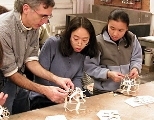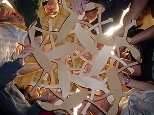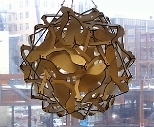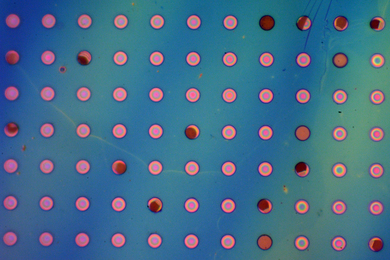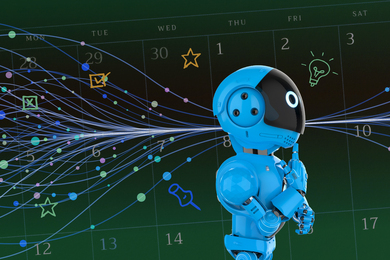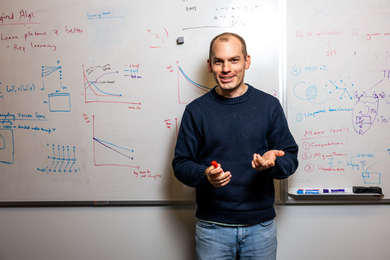They say two heads are better than one, but it took some real orchestration to get 90 heads, 30 brains, 60 arms and 180 legs working together. Artist George Hart managed to coordinate all those body parts as he choreographed 30 volunteers in assembling a hanging sculpture, "Salamanders," in just under three hours (including time for training) in the MIT Museum's wood workshop.
Hart, an MIT alumnus, was on campus as an artist-in-residence Oct. 29 to Nov. 4. As part of his residency, he gave two talks and brought with him the design of a public sculpture to be assembled by MIT volunteers and eventually hung in the Stata Center.
"Salamanders" is a polyhedral assemblage of 30 laser-cut, double-headed birch salamanders. (Not double-headed in a scary two-heads-on-one-shoulder sort of way, these friendly looking two-feet-long salamanders have heads with cheerful eyes at both ends.) The finished product is 30 inches in diameter and weighs 15 pounds. Right now it hangs in the office window of Professor Erik Demaine, who co-authored a paper on computational geometry with Hart and invited him to MIT this fall. Hart earned the S.B. in mathematics in 1977 and the Ph.D. in electrical engineering and computer science in 1987.
For Demaine, who enjoys working collaboratively on projects, the uncertainty involved in the assembly (or barn raising, as Hart called it) was a high point of Hart's stay.
"We didn't know how long it would take to put it together. You know, it might take 10 minutes and then we'd all look kind of silly or it might take all night," said Demaine, an assistant professor of electrical engineering and computer science. "George made his uncertainty clear, which made [the assembly] more exciting."
Hart and Demaine cut the wood salamanders using a laser cutter in a shop at the Computer Science and Artificial Intelligence Laboratory (CSAIL). The pieces of Baltic birch plywood were laser-engraved with ovals for the eyes, drilled and countersunk in four places for screws, glued to two wooden junction pieces and given a protective coating of tung oil.
At the same time, Hart and Demaine cut components for 30 small paper salamander sculptures so Hart could demonstrate the assembly process and give volunteers a little practice.
On the evening of assembly, the group spent an hour and 15 minutes working with the paper sculptures before tackling the real thing. Hart, who designed the sculpture with the help of an algorithm he created to assist him in his design work, gives a description of the process on his web site (http://www.georgehart.com).
"It's tricky to master how the parts weave through each other, what should be inside and what should be outside," Hart writes. "The long [salamander] legs, which make a star pattern at the fivefold junctions, are the biggest problem. The 'wrist' of each long leg must be outside the 'elbow' of the leg it crosses. The paper is flexible, allowing legs to be bent into place. But the real challenge was to design an assembly strategy that would work with rigid wooden components.
"The assembly method we chose was to begin working in the air with five parts around an imagined vertical five-fold axis. Then another five parts weave into those, making a cap of 10 parts all together."
Or as Demaine described it, 10 volunteers put together the top of the sculpture, which consisted of five rosettes of connected amphibians whose legs and heads were woven in and out of one another just perfectly, so that the only pieces actually touching were the few on the outermost shell that were glued and/or screwed together. This process was repeated with the bottom of the sculpture, and then top and bottom were woven into and attached to the "equator."
Orchestrating this chorus line in holding and weaving, vertical shifting, equator tilting, glueing and screwing was maestro Hart, who conducted the process for an hour and 45 minutes, about the duration of a good Broadway performance.
Tom Buehler, a CSAIL research specialist, videotaped the performance. Buehler's tape can be viewed on the "Salamanders" web page at http://theory.lcs.mit.edu/GeorgeHart.
A version of this article appeared in MIT Tech Talk on November 19, 2003.
